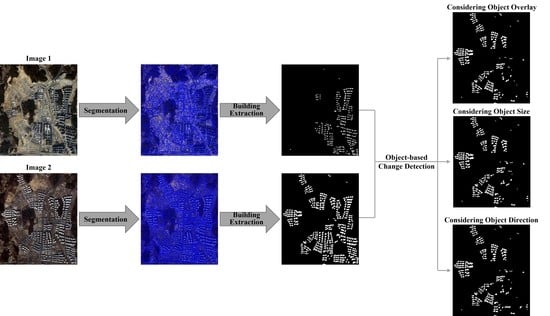Change Detection of Building Objects in High-Resolution Single-Sensor and Multi-Sensor Imagery Considering the Sun and Sensor’s Elevation and Azimuth Angles
Abstract
:1. Introduction
2. Study Site and Evaluation Criteria
2.1. Study Site
2.2. Evaluation Creteria
3. Methods
3.1. Preprocessing
3.2. Multiresolution Segmentation
3.3. Object-Based Building Detection
3.3.1. Vegetation and Shadow Detection
3.3.2. Building Candidate Detection
3.3.3. Final Building Detection Using Shadow Information
3.4. Object-Based Building Change Detection
4. Experimental Results
4.1. Building Detection Results
4.1.1. Site 1: Single-Sensor Imagery
4.1.2. Site 2: Multi-Sensor Imagery
4.2. Object-Based Building Change Detection Results
4.2.1. Site 1: Single-Sensor Imagery
4.2.2. Site 2: Multi-Sensor Imagery
5. Discussion
5.1. Site 1: Single-Sensor Imagery
5.2. Site 2: Multi-Sensor Imagery
6. Conclusions
Author Contributions
Funding
Conflicts of Interest
References
- Huang, X.; Zhang, L. A multidirectional and multiscale morphological index for automatic building extraction from multispectralgeoeye-1 imagery. Photogramm. Eng. Remote Sens. 2011, 77, 721–732. [Google Scholar] [CrossRef]
- Attarzadeh, R.; Momeni, M. Object-based rule sets and its transferability for building extraction from high resolution satellite imagery. J. Indian Soc. Remote Sens. 2018, 46, 169–178. [Google Scholar] [CrossRef]
- Du, S.; Zhang, Y.; Zou, Z.; Xu, S.; He, X.; Chen, S. Automatic building extraction from LiDAR data fusion of point and grid-based features. ISPRS J. Photogramm. Remote Sens. 2017, 130, 294–307. [Google Scholar] [CrossRef]
- Park, H.; Choi, J.; Park, W.; Park, H. Modified S 2 CVA algorithm using cross-sharpened images for unsupervised change detection. Remote Sens. 2018, 10, 3301. [Google Scholar] [CrossRef] [Green Version]
- Pang, S.; Hu, X.; Wang, Z.; Lu, Y.; Balzter, H.; Blaschke, T.; Thenkabail, P.S. Object-based analysis of airborne LiDAR data for building change detection. Remote Sens. 2014, 6, 10733–10749. [Google Scholar] [CrossRef] [Green Version]
- Meng, X.; Currit, N.; Wang, L. Morphology-based building detection from airborne lidar data. In Proceedings of the American Society for Photogrammetry and Remote Sensing-ASPRS Annual Conference, Portland, OR, USA, 28 April–2 May 2008; Volume 2, pp. 484–492. [Google Scholar]
- Yan, Y.; Tan, Z.; Su, N.; Zhao, C. Building extraction based on an optimized stacked sparse autoencoder of structure and training samples using LIDAR DSM and optical images. Sensors 2017, 17, 1957. [Google Scholar] [CrossRef] [Green Version]
- Saha, S.; Bovolo, F.; Bruzzone, L. Building change detection in VHR SAR images via unsupervised deep transcoding. IEEE Trans. Geosci. Remote Sens. 2021, 59, 1917–1929. [Google Scholar] [CrossRef]
- Zhao, L.; Zhou, X.; Kuang, G. Building detection from urban SAR image using building characteristics and contextual information. EURASIP J. Adv. Signal Process. 2013, 2013, 1–16. [Google Scholar] [CrossRef] [Green Version]
- Zha, Y.; Gao, J.; Ni, S. Use of normalized difference built-up index in automatically mapping urban areas from TM imagery. Int. J. Remote Sens. 2003, 24, 583–594. [Google Scholar] [CrossRef]
- Xu, H. A new index for delineating built-up land features in satellite imagery. Int. J. Remote Sens. 2008, 29, 4269–4276. [Google Scholar] [CrossRef]
- As-syakur, A.R.; Adnyana, I.W.S.; Arthana, I.W.; Nuarsa, I.W. Enhanced built-UP and bareness index (EBBI) for mapping built-UP and bare land in an urban area. Remote Sens. 2012, 4, 2957–2970. [Google Scholar] [CrossRef] [Green Version]
- Sirmaçek, B.; Ünsalan, C. Building detection from aerial images using invariant color features and shadow information. In Proceedings of the 2008 23rd International Symposium on Computer and Information Sciences, Istanbul, Turkey, 27–29 October 2008; pp. 1–5. [Google Scholar] [CrossRef]
- Liu, H.; Yang, M.; Chen, J.; Hou, J.; Deng, M. Line-constrained shape feature for building change detection in VHR remote sensing imagery. ISPRS Int. J. Geo-Inf. 2018, 7, 410. [Google Scholar] [CrossRef] [Green Version]
- Li, J.; Cao, J.; Feyissa, M.E.; Yang, X. Automatic building detection from very high-resolution images using multiscale morphological attribute profiles. Remote Sens. Lett. 2020, 11, 640–649. [Google Scholar] [CrossRef]
- Huang, X.; Zhang, L.; Zhu, T. Building change detection from multitemporal high-resolution remotely sensed images based on a morphological building index. IEEE J. Sel. Top. Appl. Earth Obs. Remote Sens. 2013, 7, 105–115. [Google Scholar] [CrossRef]
- Huang, X.; Zhu, T.; Zhang, L.; Tang, Y. A novel building change index for automatic building change detection from high-resolution remote sensing imagery. Remote Sens. Lett. 2014, 5, 713–722. [Google Scholar] [CrossRef]
- Sheikh, M.A.A.; Kole, A.; Maity, T. A multi-level approach for change detection of buildings using satellite imagery. Int. J. Artif. Intell. Tools 2018, 27, 1850031. [Google Scholar] [CrossRef]
- Javed, A.; Jung, S.; Lee, W.H.; Han, Y. Object-based building change detection by fusing pixel-level change detection results generated from morphological building index. Remote Sens. 2020, 12, 2952. [Google Scholar] [CrossRef]
- Gong, J.; Hu, X.; Pang, S.; Li, K. Patch matching and dense crf-based co-refinement for building change detection from bi-temporal aerial images. Sensors 2019, 19, 1557. [Google Scholar] [CrossRef] [Green Version]
- Wang, B.; Choi, J.; Choi, S.; Lee, S.; Wu, P.; Gao, Y. Image fusion-based land cover change detection using multi-temporal high-resolution satellite images. Remote Sens. 2017, 9, 804. [Google Scholar] [CrossRef] [Green Version]
- Keyport, R.N.; Oommen, T.; Martha, T.R.; Sajinkumar, K.S.; Gierke, J.S. A comparative analysis of pixel-and object-based detection of landslides from very high-resolution images. Int. J. Appl. Earth Obs. Geoinf. 2018, 64, 1–11. [Google Scholar] [CrossRef]
- Tang, Y.; Zhang, L.; Huang, X. Object-oriented change detection based on the Kolmogorov–Smirnov test using high-resolution multispectral imagery. Int. J. Remote Sens. 2011, 32, 5719–5740. [Google Scholar] [CrossRef]
- Ma, L.; Li, M.; Blaschke, T.; Ma, X.; Tiede, D.; Cheng, L.; Chen, Z.; Chen, D. Object-based change detection in urban areas: The effects of segmentation strategy, scale, and feature space on unsupervised methods. Remote Sens. 2016, 8, 761. [Google Scholar] [CrossRef] [Green Version]
- Im, J.; Jensen, J.R.; Tullis, J.A. Object-based change detection using correlation image analysis and image segmentation. Int. J. Remote Sens. 2008, 29, 399–423. [Google Scholar] [CrossRef]
- Leichtle, T.; Geiß, C.; Wurm, M.; Lakes, T.; Taubenböck, H. Unsupervised change detection in VHR remote sensing imagery–an object-based clustering approach in a dynamic urban environment. Int. J. Appl. Earth Obs. Geoinf. 2017, 54, 15–27. [Google Scholar] [CrossRef]
- Zhang, X.; Xiao, P.; Feng, X.; Yuan, M. Separate segmentation of multi-temporal high-resolution remote sensing images for object-based change detection in urban area. Remote Sens. Environ. 2017, 201, 243–255. [Google Scholar] [CrossRef]
- Peng, J.; Liu, Y.C. Model and context-driven building extraction in dense urban aerial images. Int. J. Remote Sens. 2005, 26, 1289–1307. [Google Scholar] [CrossRef]
- Katartzis, A.; Sahli, H. A stochastic framework for the identification of building rooftops using a single remote sensing image. IEEE Trans. Geosci. Remote Sens. 2008, 46, 259–271. [Google Scholar] [CrossRef]
- Izadi, M.; Saeedi, P. Three-dimensional polygonal building model estimation from single satellite images. IEEE Trans. Geosci. Remote Sens. 2012, 50, 2254–2272. [Google Scholar] [CrossRef]
- Ok, A.O. Automated detection of buildings from single VHR multispectral images using shadow information and graph cuts. ISPRS J. Photogramm. Remote Sens. 2013, 86, 21–40. [Google Scholar] [CrossRef]
- Gao, X.; Wang, M.; Yang, Y.; Li, G. Building extraction from RGB VHR images using shifted shadow algorithm. IEEE Access 2018, 6, 22034–22045. [Google Scholar] [CrossRef]
- Liasis, G.; Stavrou, S. Satellite images analysis for shadow detection and building height estimation. ISPRS J. Photogramm. Remote Sens. 2016, 119, 437–450. [Google Scholar] [CrossRef]
- Zhou, G.; Sha, H. Building shadow detection on ghost images. Remote Sens. 2020, 12, 679. [Google Scholar] [CrossRef] [Green Version]
- Hu, L.; Zheng, J.; Gao, F. A building extraction method using shadow in high resolution multispectral images. Int. Geosci. Remote Sens. Symp. 2011, 1862–1865. [Google Scholar] [CrossRef]
- Jung, S.J.; Kim, T.H.; Lee, W.H.; Han, Y.K. Object-based change detection using various pixel-based change detection results and registration noise. J. Korean Soc. Surv. Geod. Photogramm. Cartogr. 2019, 37, 481–489. [Google Scholar] [CrossRef]
- Jung, S.; Park, J.; Lee, W.H.; Han, Y. Object-based building change detection using azimuth and elevation angles of sun and platform in the multi-sensor images. Korean J. Remote Sens. 2020, 36, 989–1006. [Google Scholar] [CrossRef]
- Benarchid, O.; Raissouni, N. Building extraction using object-based classification and shadow information in very high resolution multispectral images, a case study: Tetuan, Morocco. Can. J. Image Process. Comput. Vis. 2013, 4, 1–8. [Google Scholar]
- Cooner, A.J.; Shao, Y.; Campbell, J.B. Detection of urban damage using remote sensing and machine learning algorithms: Revisiting the 2010 Haiti earthquake. Remote Sens. 2016, 8, 868. [Google Scholar] [CrossRef] [Green Version]
- Haralick, R.M.; Dinstein, I.; Shanmugam, K. Textural features for image classification. IEEE Trans. Syst. Man Cybern. 1973, SMC-3, 610–621. [Google Scholar] [CrossRef] [Green Version]
- Sheen, D. A generalized Green’s theorem. Appl. Math. Lett. 1992, 5, 95–98. [Google Scholar] [CrossRef] [Green Version]
- Suliman, A.; Zhang, Y. Development of line-of-sight digital surface model for co-registering off-nadir VHR satellite imagery with elevation data. IEEE J. Sel. Top. Appl. Earth Obs. Remote Sens. 2015, 8, 1913–1923. [Google Scholar] [CrossRef]


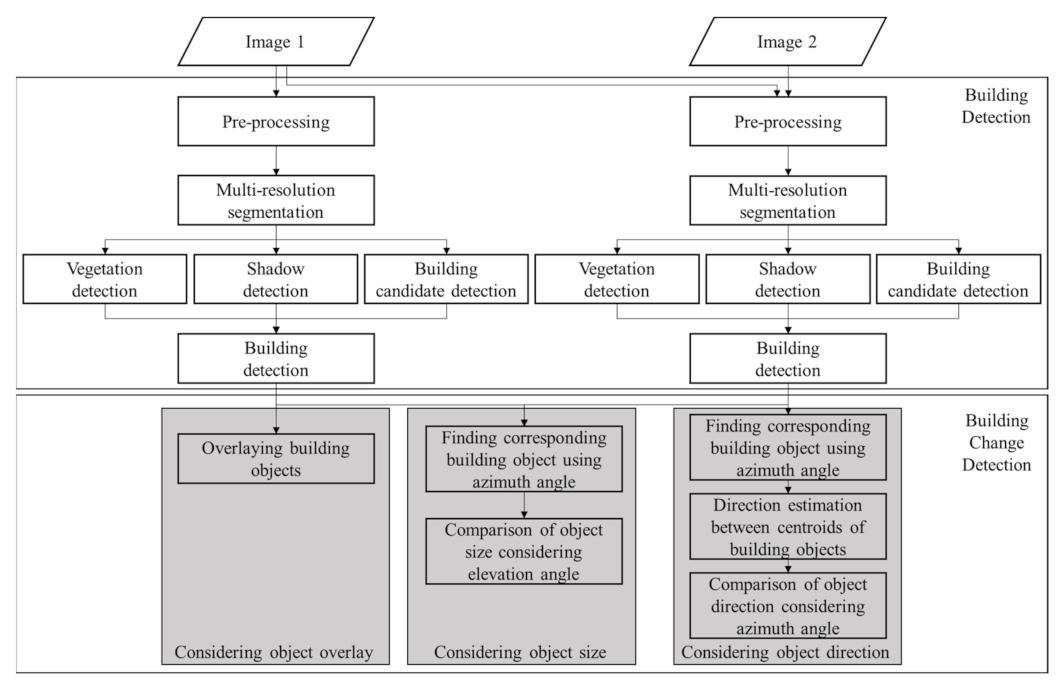
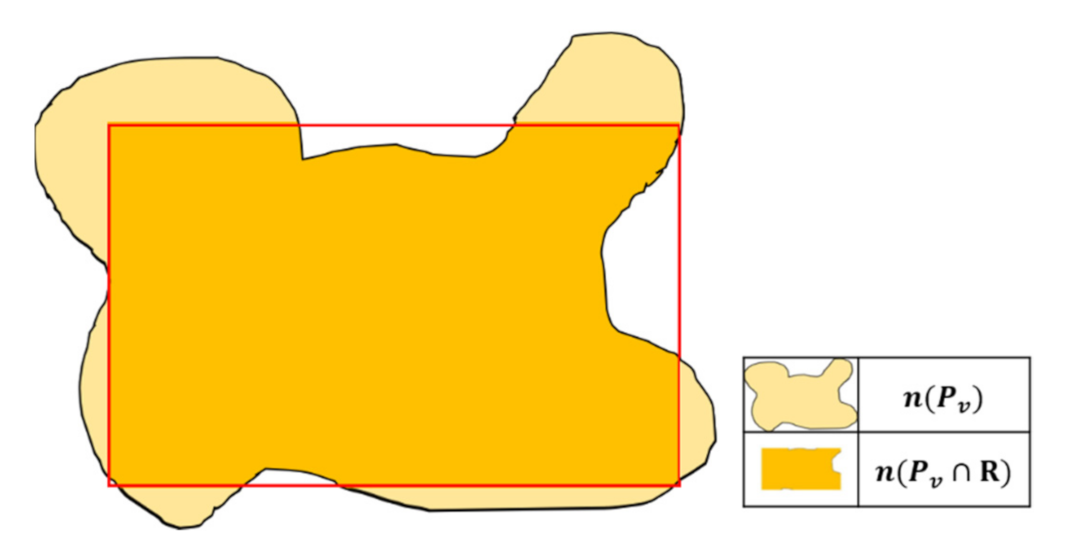

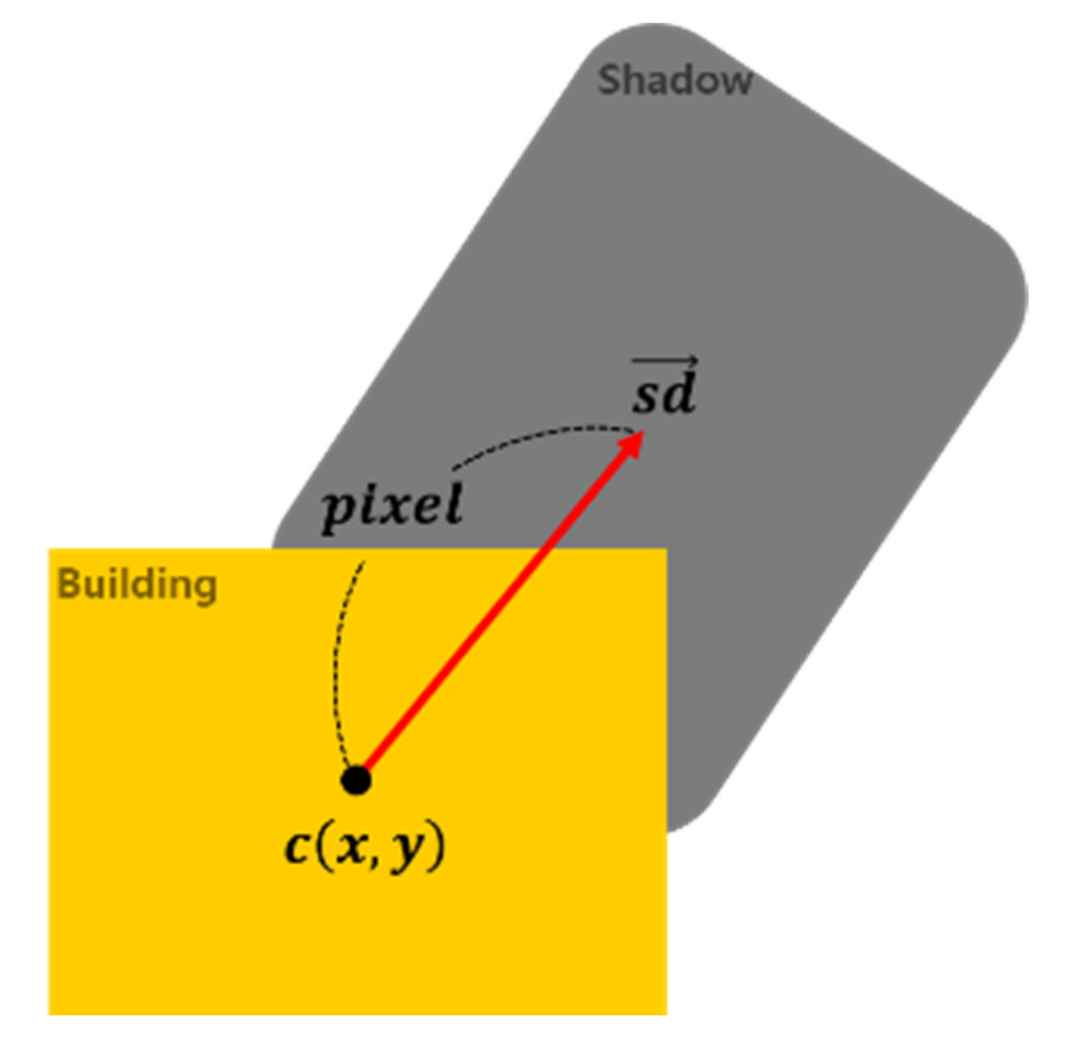

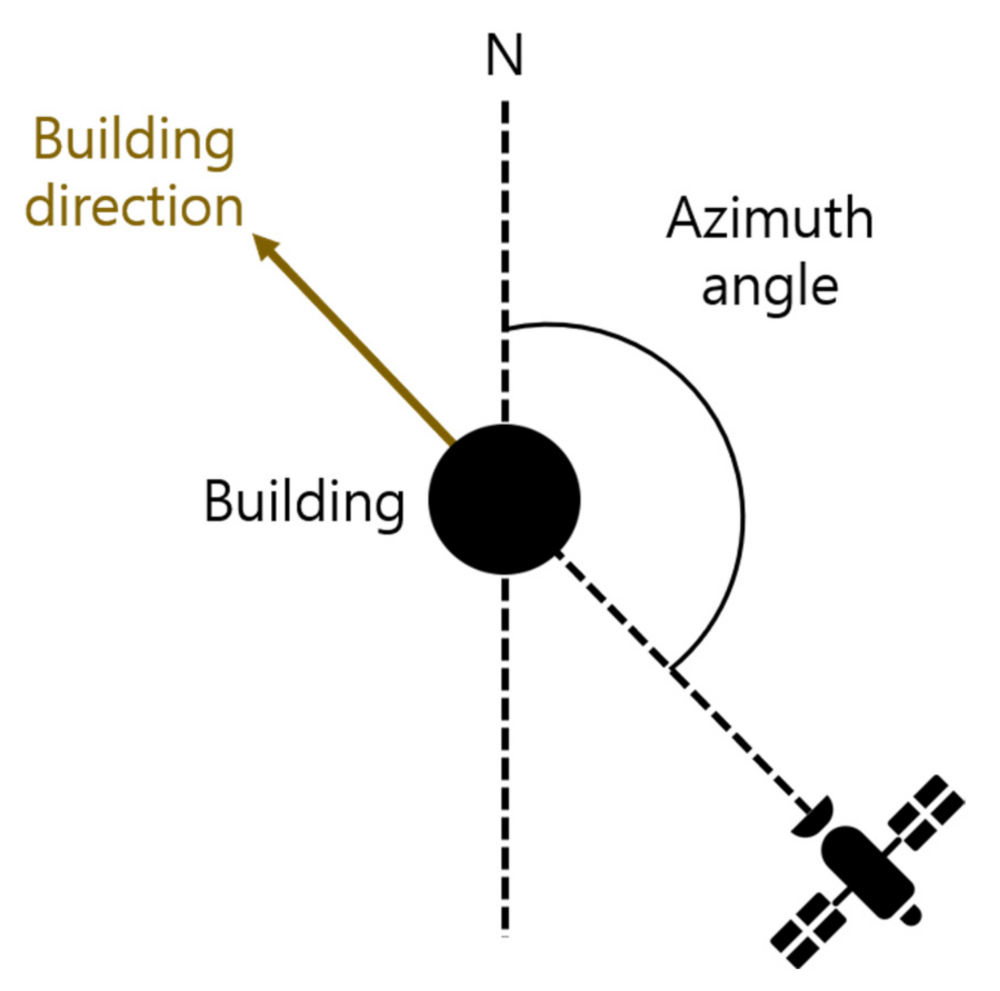
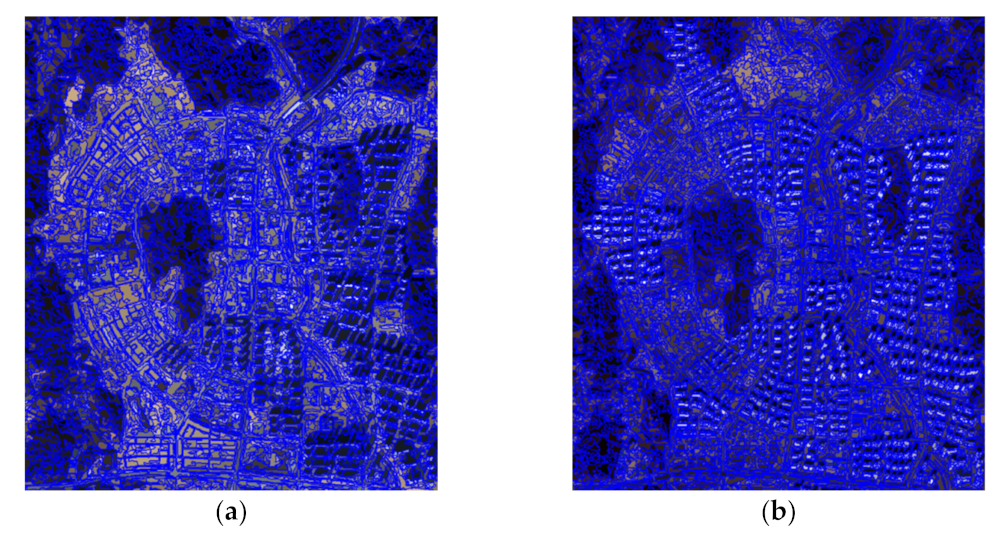
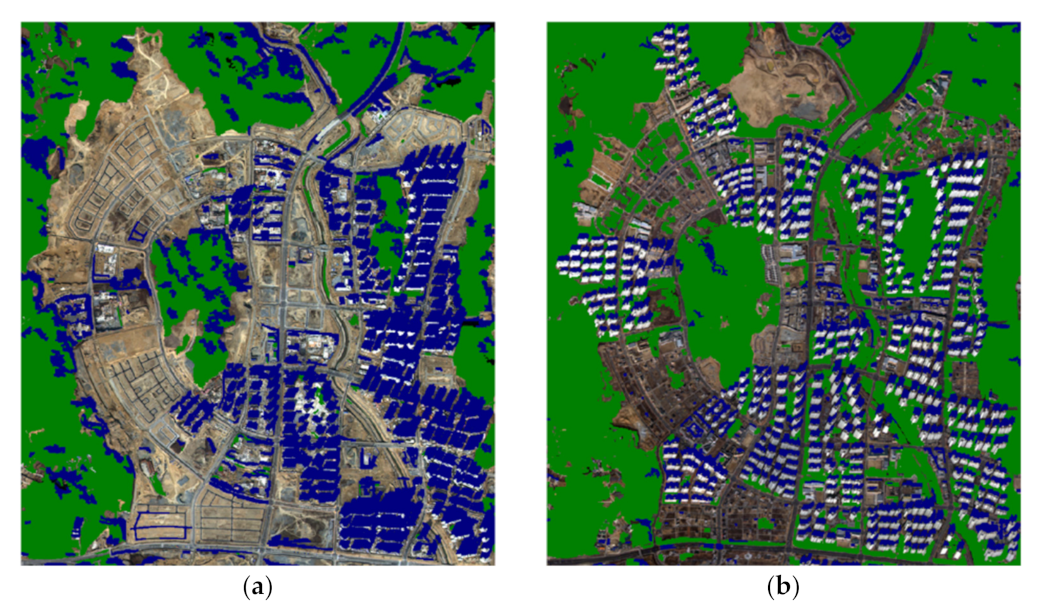

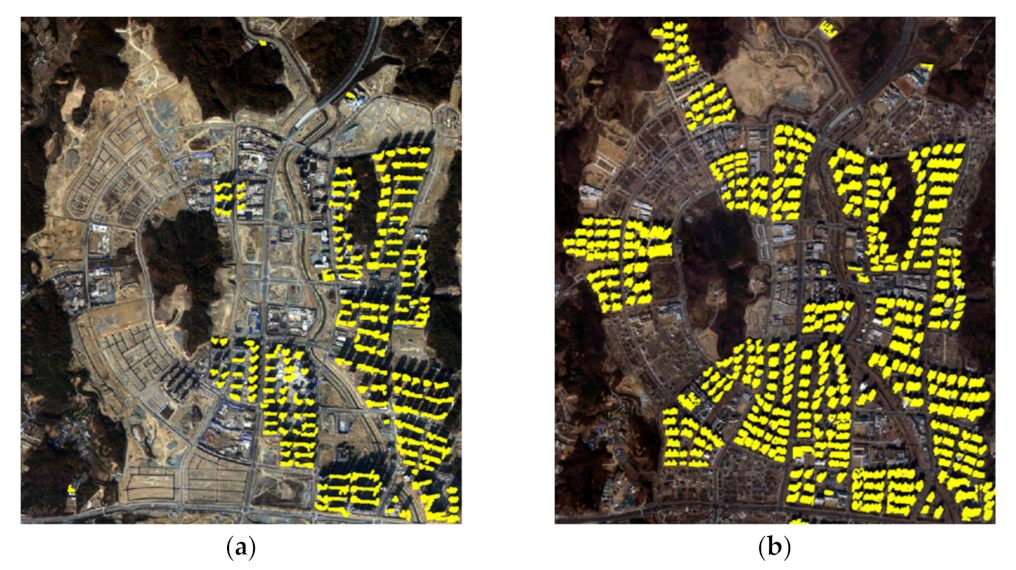
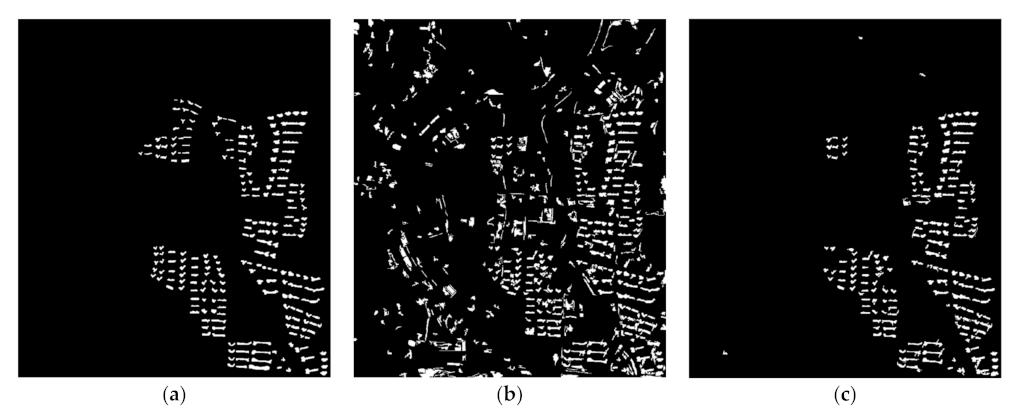
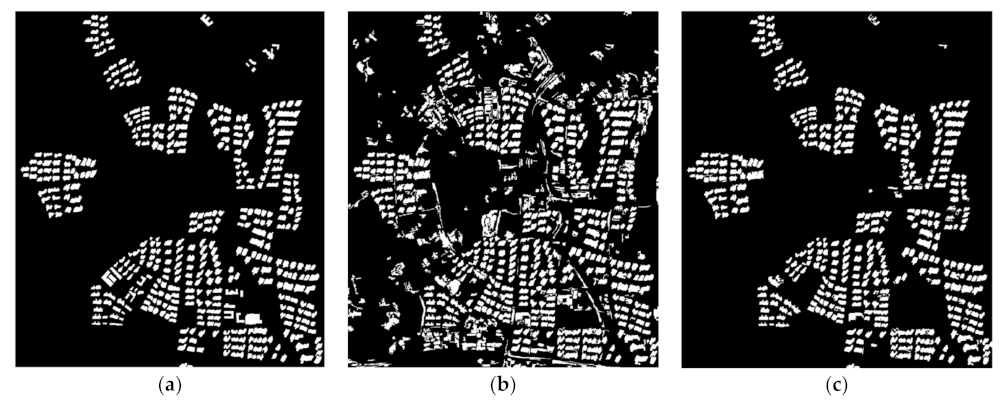

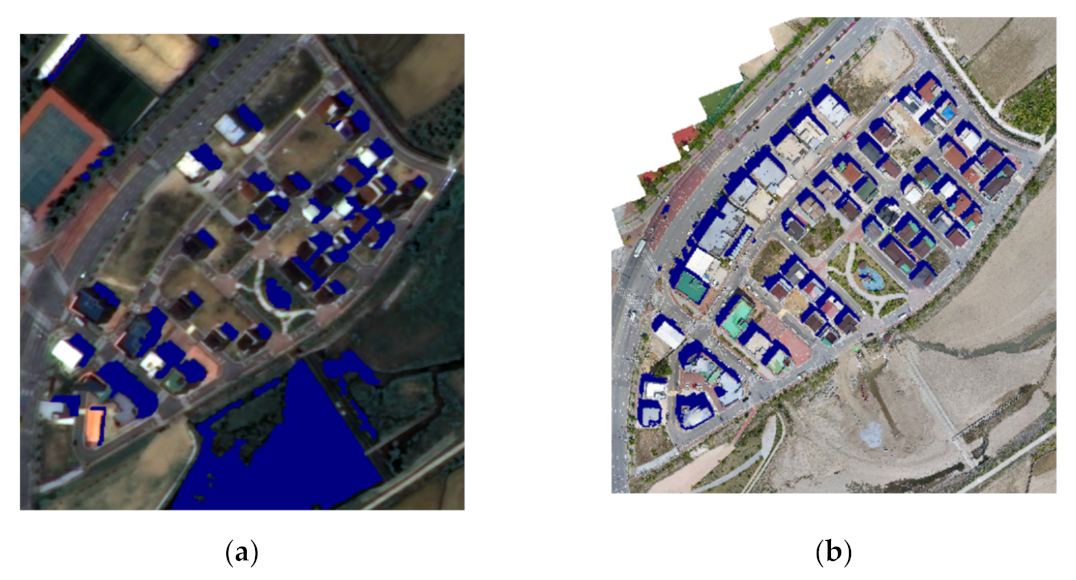
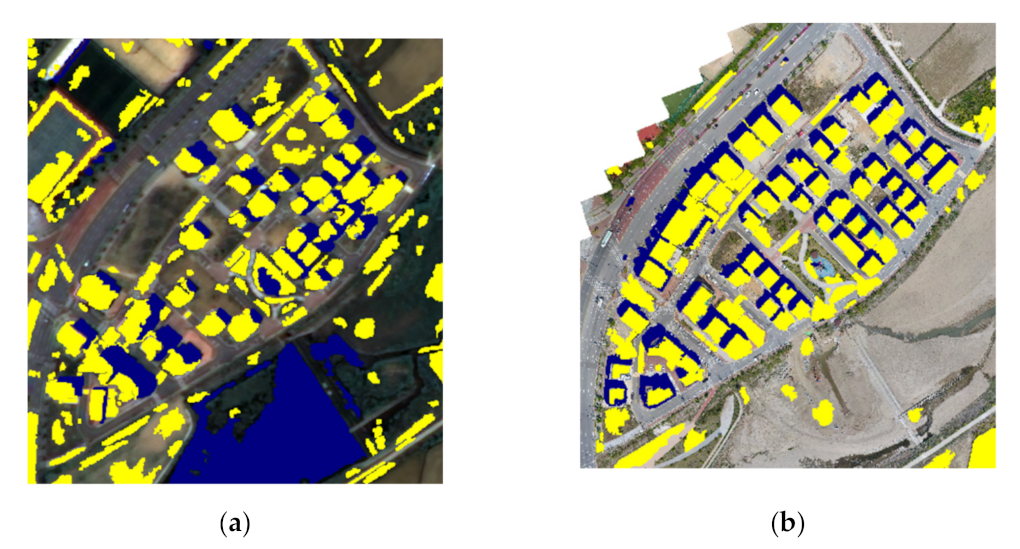

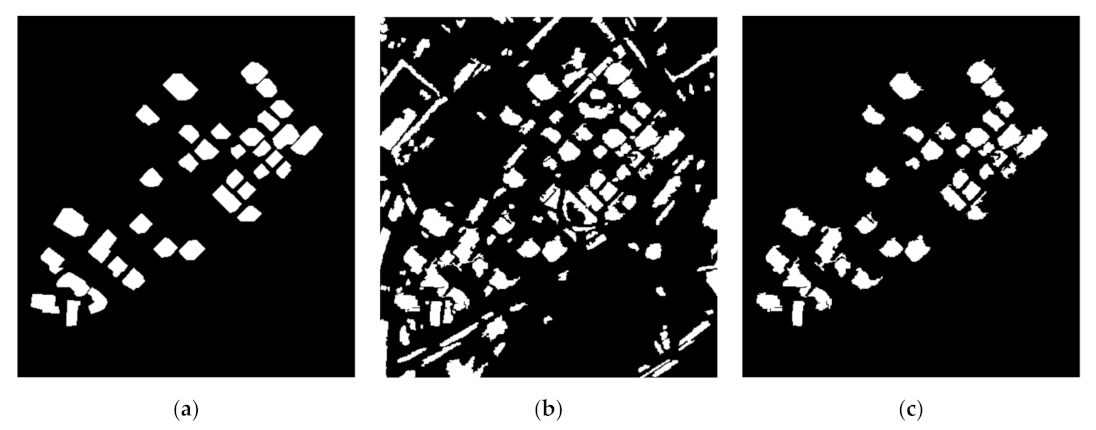
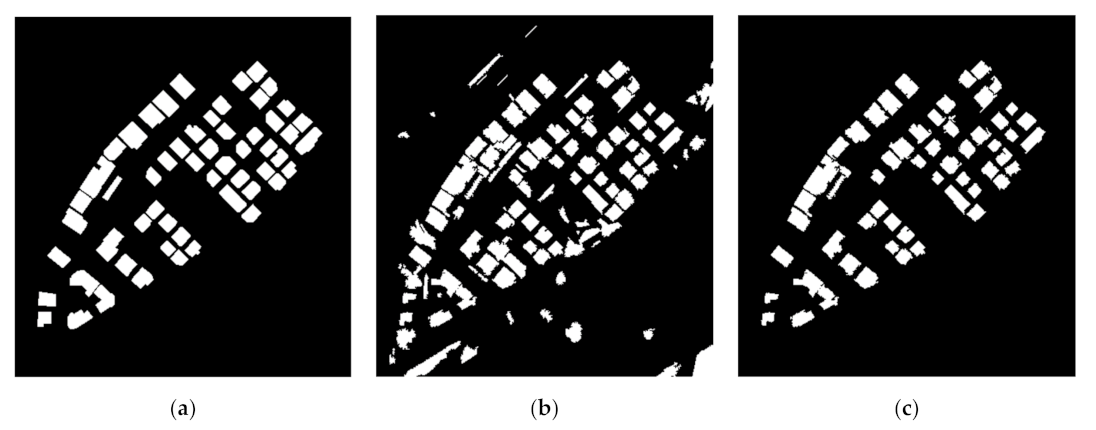
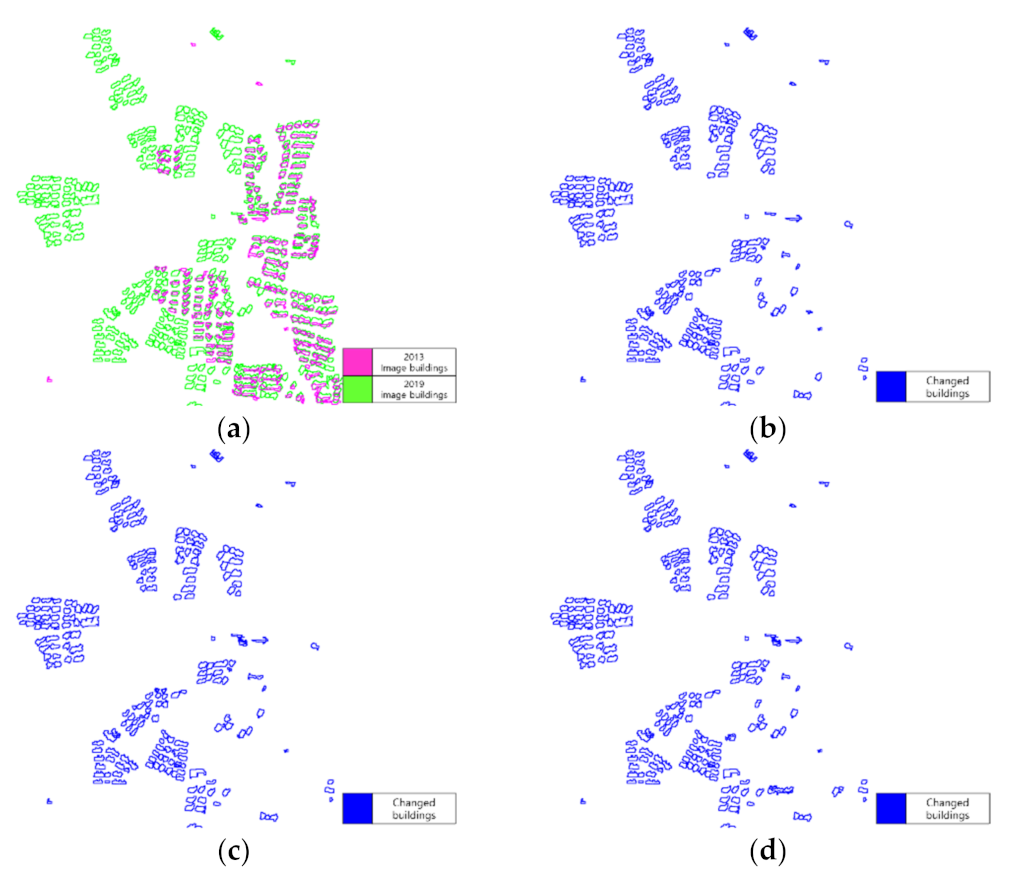
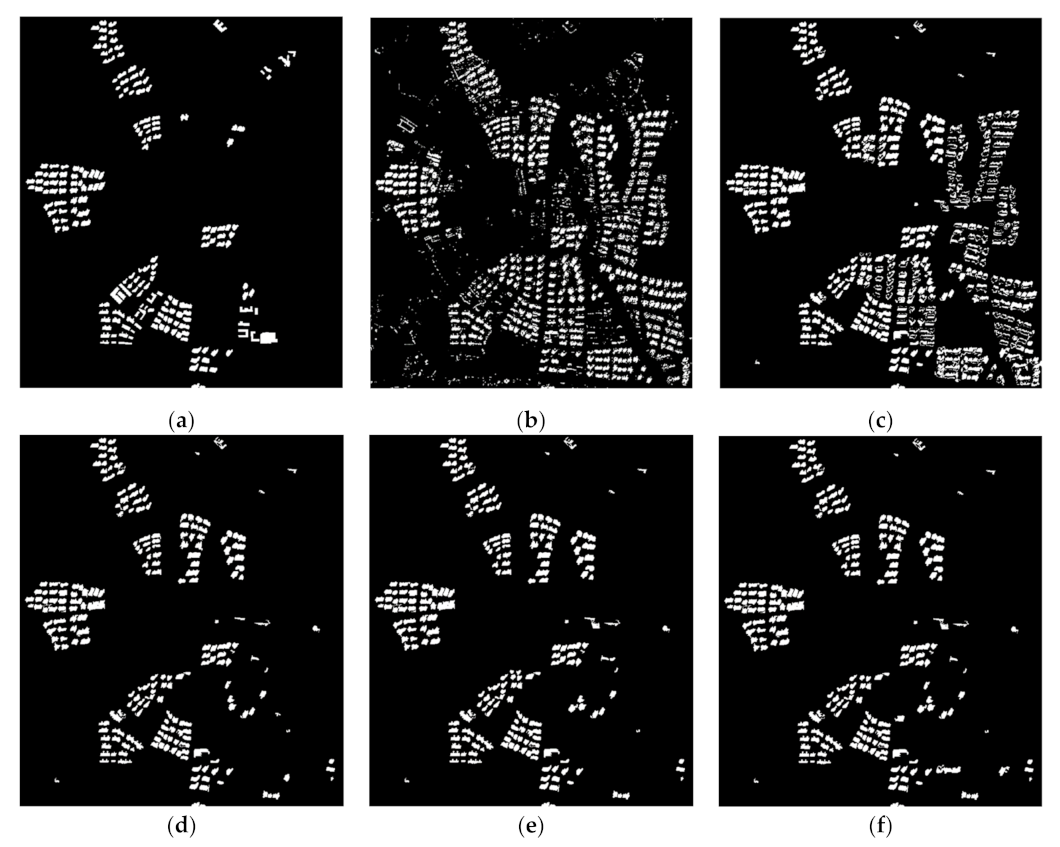
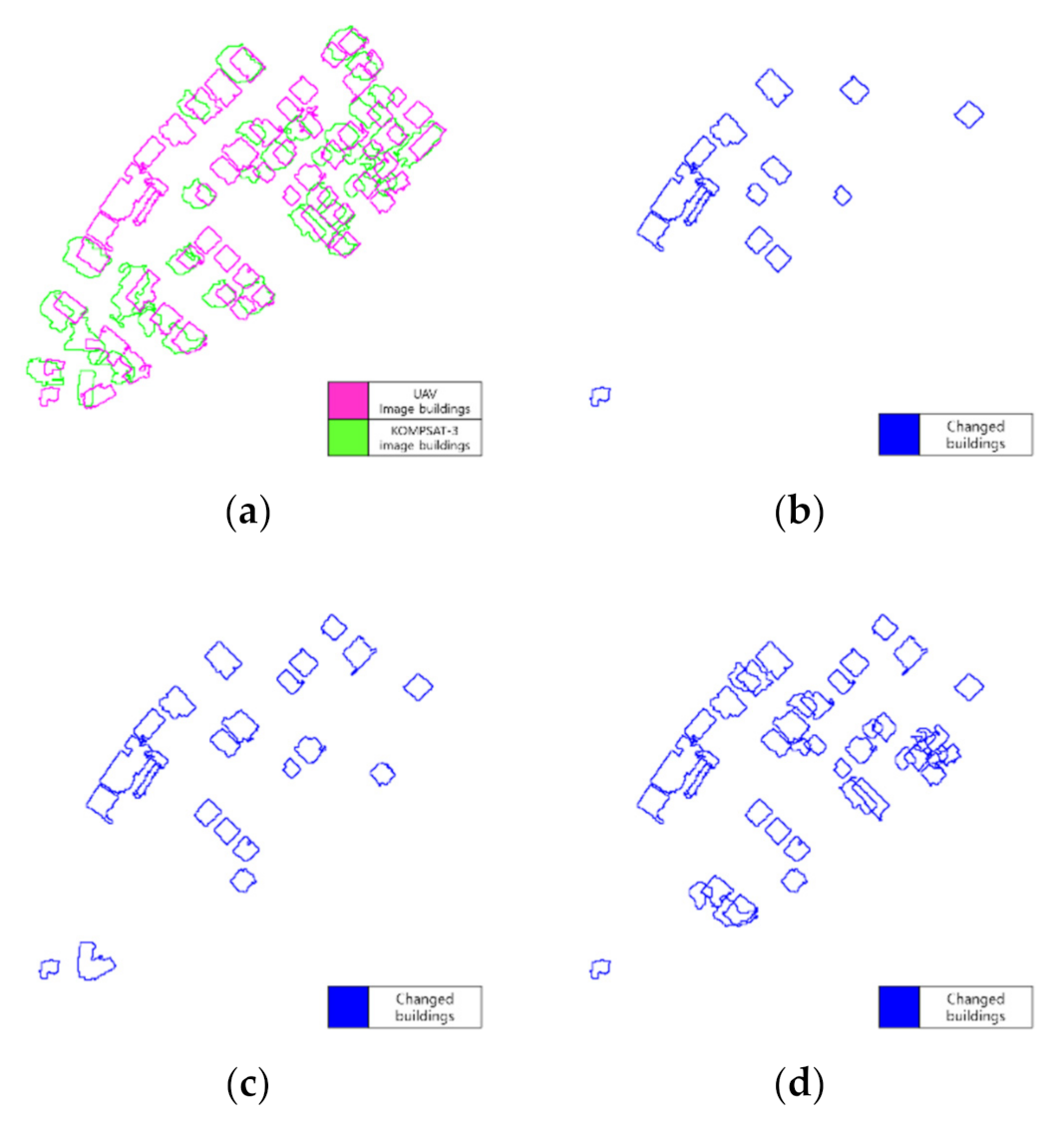

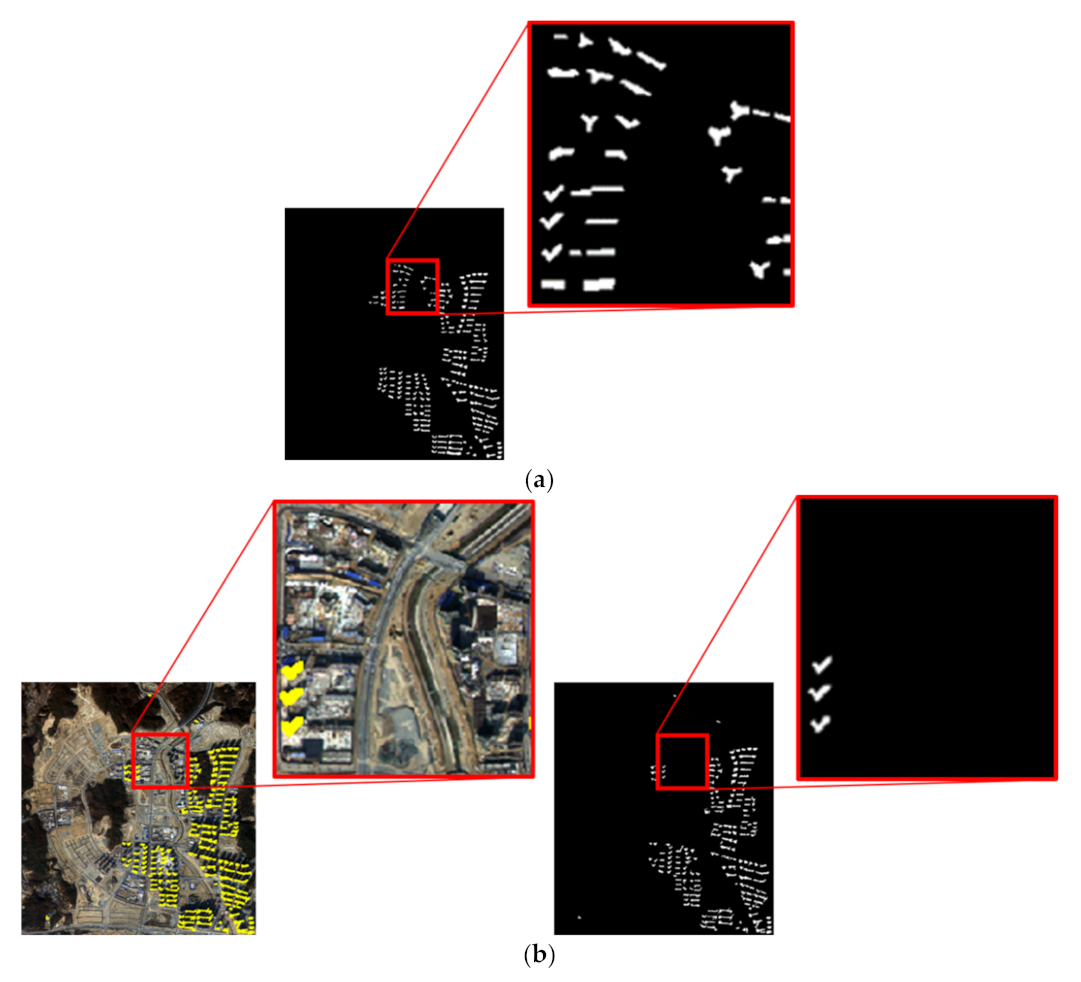
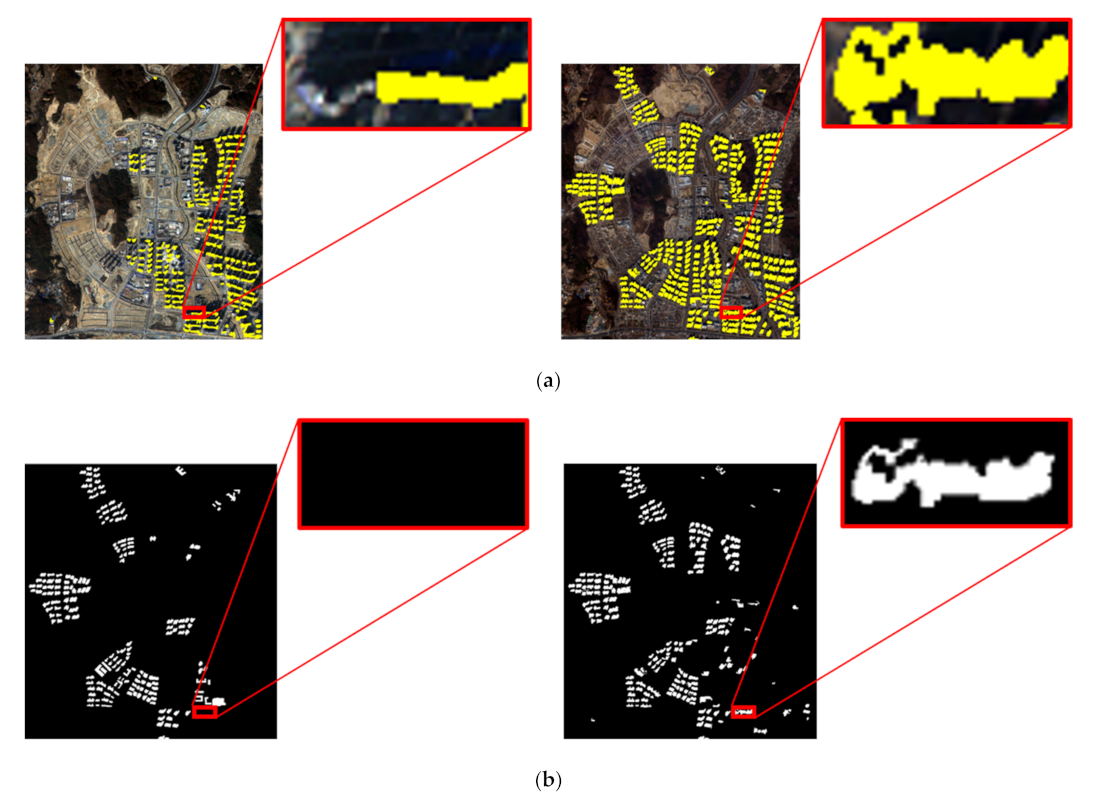
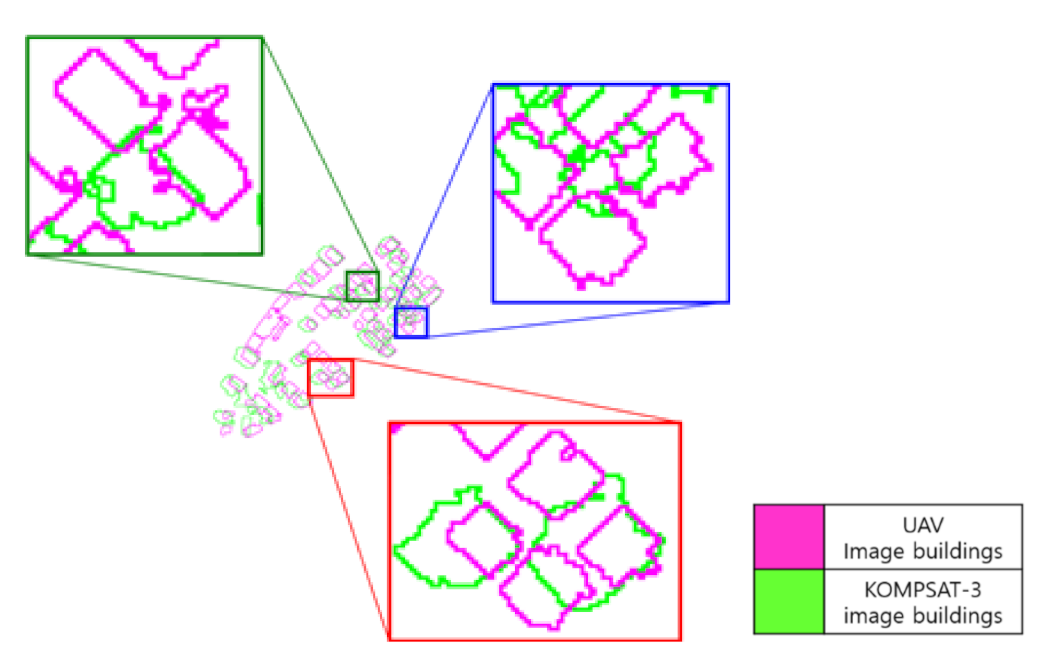
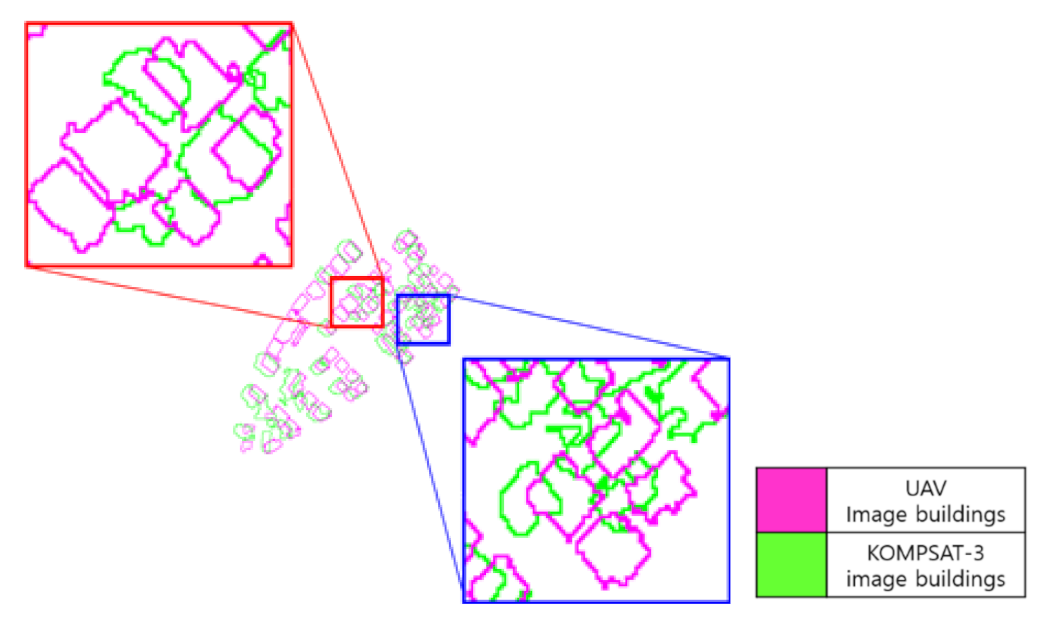
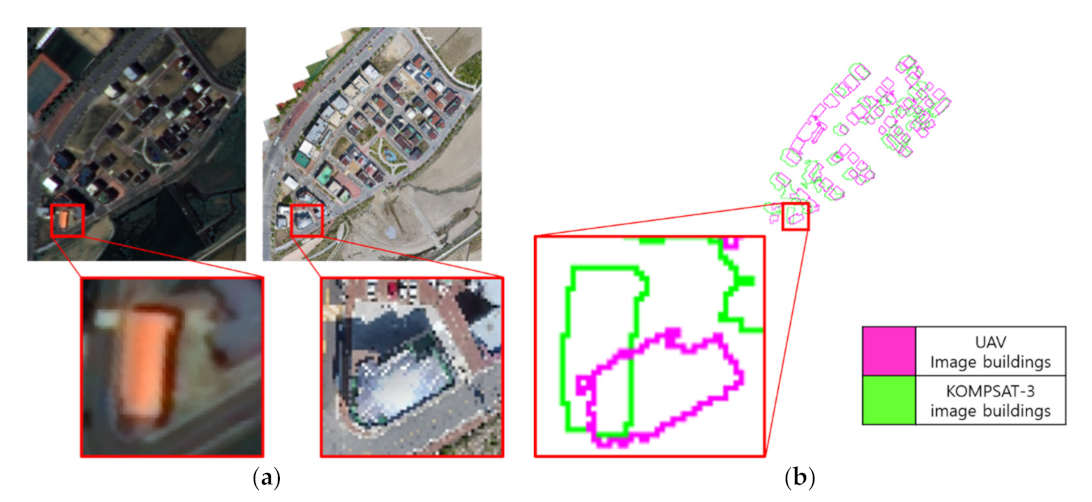
| Sensor | KOMPSAT-3 |
|---|---|
| Spatial resolution | Pan: 0.7 m MS: 2.8 m |
| Spectral bands | >Pan: 450–900 nm Blue: 450–520 nm Green: 520–600 nm Red: 630–690 nm NIR: 760–900 nm |
| >Swath width | >≥15 km (at nadir) |
| Radiometric resolution | 14 bits |
| UAV: Inspire 2 | Camera: Zenmuse X4S | ||
|---|---|---|---|
 | 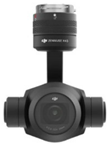 | ||
| Weight | 3400 g | Weight | 253 g |
| Speed | Max: 94 km/h | FOV | 84° |
| Flight altitude | ≤5000 m | Focal length | 8.8 mm |
| Flight time | ≤27 min | Image size | 4864 × 3648 pixels |
| Hovering accuracy | Vertical: 0.5 m Horizontal: 1.5 m | IOS | 100 |
| Sensor | KOMPSAT-3 | ||
|---|---|---|---|
| Acquisition date | 16 November 2013 | 26 February 2019 | |
| Resolution | 2.8 m (MS) | ||
| Image size | 936 × 1076 pixels | ||
| Location | Sejong-si, South Korea | ||
| Sensor angle | Azimuth | 261.369° | 207.623° |
| Elevation | 79.760° | 62.328° | |
| Incidence | 10.240° | 27.672° | |
| Sun angle | Azimuth | 204.811° | 198.504° |
| Elevation | 33.608° | 47.451° | |
| Sensor | KOMPSAT-3 | UAV | |
|---|---|---|---|
| Acquisition date | 18 May 2016 | 28 April 2020 | |
| Resolution | 0.7 m (pan-sharpened) | 0.7 m | |
| Image size | 437 × 460 (pixels) | ||
| Location | Sangju-si, South Korea | ||
| Sensor angle | Azimuth | 81.429° | - |
| Elevation | 57.892° | 90° (nadir) | |
| Incidence | 32.108° | 0° (nadir) | |
| Sun angle | Azimuth | 225.153° | 155.893° |
| Elevation | 69.085° | 66.136° | |
| Reference Data | |||
|---|---|---|---|
| Condition Positive (CP) | Condition Negative (CN) | ||
| Results | Prediction Positive (PP) | True Positive (TP) | False Positive (FP) |
| Prediction Negative (PN) | False Negative (FN) | True Negative (TN) | |
| Images | Scale | Shape | Compactness | Number of Objects |
|---|---|---|---|---|
| 2013 image | 90 | 0.1 | 0.9 | 4899 |
| 2019 image | 90 | 0.1 | 0.9 | 8396 |
| Image | Evaluation Indicator | without Shadow | with Shadow |
|---|---|---|---|
| 2013 image | False alarm | 0.058 | 0.041 |
| Miss rate | 0.178 | 0.183 | |
| F1-score | 0.459 | 0.824 | |
| Kappa | 0.433 | 0.837 | |
| 2019 image | False alarm | 0.095 | 0.009 |
| Miss rate | 0.084 | 0.059 | |
| F1-score | 0.694 | 0.917 | |
| Kappa | 0.642 | 0.906 |
| Images | Scale | Shape | Compactness | Number of Objects |
|---|---|---|---|---|
| KOMPSAT-3 image | 120 | 0.1 | 0.9 | 1023 |
| UAV image | 30 | 0.1 | 0.9 | 725 |
| Images | Shadow | without Shadow | with Shadow |
|---|---|---|---|
| KOMPSAT-3 image | False alarm | 0.152 | 0.008 |
| Miss rate | 0.155 | 0.158 | |
| F1-score | 0.488 | 0.876 | |
| Kappa | 0.417 | 0.865 | |
| UAV image | False alarm | 0.065 | 0.006 |
| Miss rate | 0.196 | 0.199 | |
| F1-score | 0.696 | 0.867 | |
| Kappa | 0.651 | 0.852 |
| MBI [19] | Pixel-Based Comparison | Object-Based Method | |||
|---|---|---|---|---|---|
| Considering Overlay | Considering Size by Elevation Angle | Considering Direction by Azimuth Angle | |||
| False alarm | 0.078 | 0.062 | 0.018 | 0.018 | 0.020 |
| Miss rate | 0.353 | 0.175 | 0.175 | 0.176 | 0.176 |
| F1-score | 0.400 | 0.531 | 0.754 | 0.750 | 0.739 |
| Kappa | 0.358 | 0.500 | 0.741 | 0.737 | 0.725 |
| MBI [19] | Pixel-Based Comparison | Object-Based Method | |||
|---|---|---|---|---|---|
| Considering Overlay | Considering Size by Elevation Angle | Considering Direction by Azimuth Angle | |||
| False alarm | 0.096 | 0.081 | 0.003 | 0.031 | 0.004 |
| Miss rate | 0.476 | 0.182 | 0.459 | 0.202 | 0.138 |
| F1-score | 0.369 | 0.470 | 0.677 | 0.655 | 0.891 |
| Kappa | 0.327 | 0.433 | 0.666 | 0.635 | 0.886 |
Publisher’s Note: MDPI stays neutral with regard to jurisdictional claims in published maps and institutional affiliations. |
© 2021 by the authors. Licensee MDPI, Basel, Switzerland. This article is an open access article distributed under the terms and conditions of the Creative Commons Attribution (CC BY) license (https://creativecommons.org/licenses/by/4.0/).
Share and Cite
Jung, S.; Lee, W.H.; Han, Y. Change Detection of Building Objects in High-Resolution Single-Sensor and Multi-Sensor Imagery Considering the Sun and Sensor’s Elevation and Azimuth Angles. Remote Sens. 2021, 13, 3660. https://doi.org/10.3390/rs13183660
Jung S, Lee WH, Han Y. Change Detection of Building Objects in High-Resolution Single-Sensor and Multi-Sensor Imagery Considering the Sun and Sensor’s Elevation and Azimuth Angles. Remote Sensing. 2021; 13(18):3660. https://doi.org/10.3390/rs13183660
Chicago/Turabian StyleJung, Sejung, Won Hee Lee, and Youkyung Han. 2021. "Change Detection of Building Objects in High-Resolution Single-Sensor and Multi-Sensor Imagery Considering the Sun and Sensor’s Elevation and Azimuth Angles" Remote Sensing 13, no. 18: 3660. https://doi.org/10.3390/rs13183660
APA StyleJung, S., Lee, W. H., & Han, Y. (2021). Change Detection of Building Objects in High-Resolution Single-Sensor and Multi-Sensor Imagery Considering the Sun and Sensor’s Elevation and Azimuth Angles. Remote Sensing, 13(18), 3660. https://doi.org/10.3390/rs13183660






